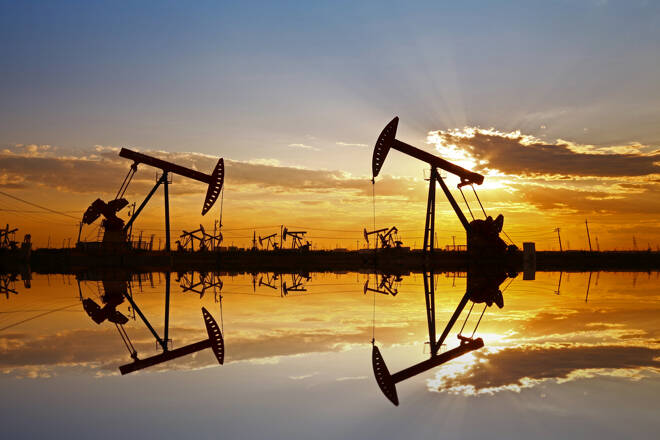Advertisement
Advertisement
Energy Forecast 2023 – Mostly Lower on Weak China Demand, Economic Contraction
By:
Rising global interest rates are expected to take their toll on the world economy in 2023, pressuring crude oil prices, its products and natural gas.
Crude oil, fuel products and natural gas swung wildly in 2022, soaring on tight supplies caused by huge demand from Europe amid the war in Ukraine, then sliding on weaker demand from top importer China, worries about an economic contraction, higher production and weather issues.
By the end of the year, crude oil was able to post nearly 10% gains, while natural gas managed to eke out a small gain. Gasoline and distillates were also higher for the year.
One word sums up the year: Volatile.
Crude Oil Climbs as Russia Invades Ukraine
U.S. benchmark West Texas Intermediate and international-benchmark Brent crude oil futures climbed to multi-year highs in March as Russia’s invasion of Ukraine upended global crude flows, with Brent reaching $139.18 a barrel, highest since 2008. Prices fell rapidly in the second half as central banks hiked interest rates and fanned worries of recession.
For the year, Brent gained about 10%, after jumping 50% in 2021. US WTI crude rose nearly 7% in 2022, following a 55% gain in 2021. Both benchmarks fell sharply in 2020 as the COVID-19 pandemic slashed fuel demand.
Inflation, Short-Supply Drives US Gasoline Prices Higher
US gasoline prices rallied to near record highs in some areas of the country on rapidly rising inflation and bottlenecks at refineries. But the rally came to a halt as a series of aggressive rate hikes by the U.S. Federal Reserve helped slow down the surge in inflation. Meanwhile, U.S. President Joe Biden ordered the release of massive amounts of oil from the U.S. Strategic Petroleum Reserve (SPR). This assured that refineries would have enough crude oil.
Distillate Fuels
Distillate fuels (heating oil and diesel fuels) rallied sharply higher early in 2022 as European demand surged. However, prices started to weaken during the fourth quarter of 2022 as inventories rose due to lower demand. This is often a sign of a looming recession.
Promising Start for Natural Gas Fades on Production Surge, Lower LNG Demand
Natural gas futures traded sharply higher nearly half the year as chances of a supply deficit into the winter heating season rose amid huge demand for liquefied natural gas (LNG) from Europe and Asia.
Following Russia’s invasion of Ukraine, natural gas supply flowing into Europe slowed, prompting European nations to demand U.S. LNG in order to assure adequate supply ahead of winter. This drove U.S. natural gas prices above $10, or a multi-year high.
The rally came to a screeching halt, however, on June 8 when a fire and explosion at the Freeport LNG facility halted production for the year. This was a huge blow to domestic demand.
Prices retreated the rest of the year as European demand fell, domestic demand retreated and U.S. production increased.
2023 Outlook
Rising global interest rates are expected to take their toll on the world economy in 2023. This is expected to keep a lid on crude oil prices, its products and natural gas. The drop in demand is expected to drive up inventories, which may be enough to offset any attempts by Russia to cut output.
Meanwhile, China’s oil demand restrictions, which were eased in December, is likely to limit demand recovery hopes. China needs to open its economy completely to drive up demand. Until that happens, the demand picture will remain clouded. The world’s top oil importer and second-biggest consumer in 2022 posted its first drop in oil demand in years.
Additionally, while China’s oil demand is expected to recover in 2023, a recent surge in COVID-19 cases means demand will remain below average for at least the first quarter of the year.
As far as crude oil prices are concerned, a survey of 30 economists and analysts forecast Brent would average $89.37 a barrel in 2023, about 4.6% lower than the consensus in a November survey. U.S. crude is projected to average $84.84 per barrel in 2023.
Rising U.S. crude oil inventories will mean there will be plenty of oil around for gasoline and distillate refining. Additionally, a drop in inflation amid rising rates should also weigh on prices for products.
Natural gas demand is expected to fall in 2023 and production is expected to rise. These factors should keep a lid on prices.
Don’t Forget the Wildcards
There could be a few wildcards in 2023 that may lead to heightened volatility – Rate hikes by the major central banks could lead to a global recession, the war in the Ukraine could escalate by expanding to other countries or the war between Russia and Ukraine could come to an end.
A global recession could be devastating to prices. Demand would tumble and supply would rise. Although this could prompt OPEC+ to trim production.
An escalation of the war could drive prices higher if global supplies are reduced and Europe continues to demand U.S. crude oil, products and natural gas. But this would also increase the odds of a long recession.
Prices are likely to stabilize if the war ends, but may not rally considerably until the Western world decides what to do about Russian crude oil and natural gas production. Russian output could either flood the market, leading to lower prices, or Western nations may decide to punish Russia by forbidding it to release supply.
For a look at all of today’s economic events, check out our economic calendar.
About the Author
James Hyerczykauthor
James Hyerczyk is a U.S. based seasoned technical analyst and educator with over 40 years of experience in market analysis and trading, specializing in chart patterns and price movement. He is the author of two books on technical analysis and has a background in both futures and stock markets.
Advertisement
